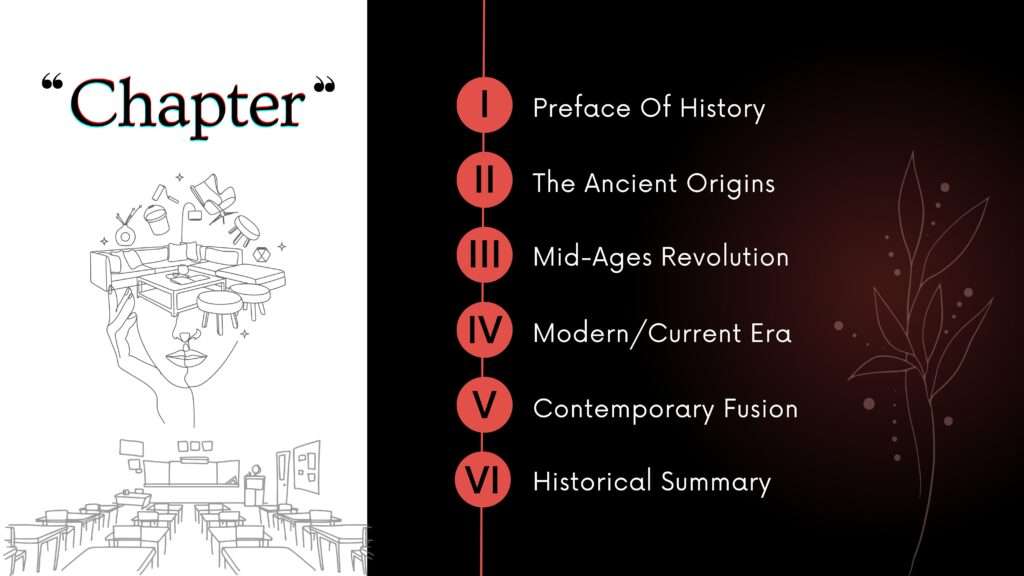
Table of Contents
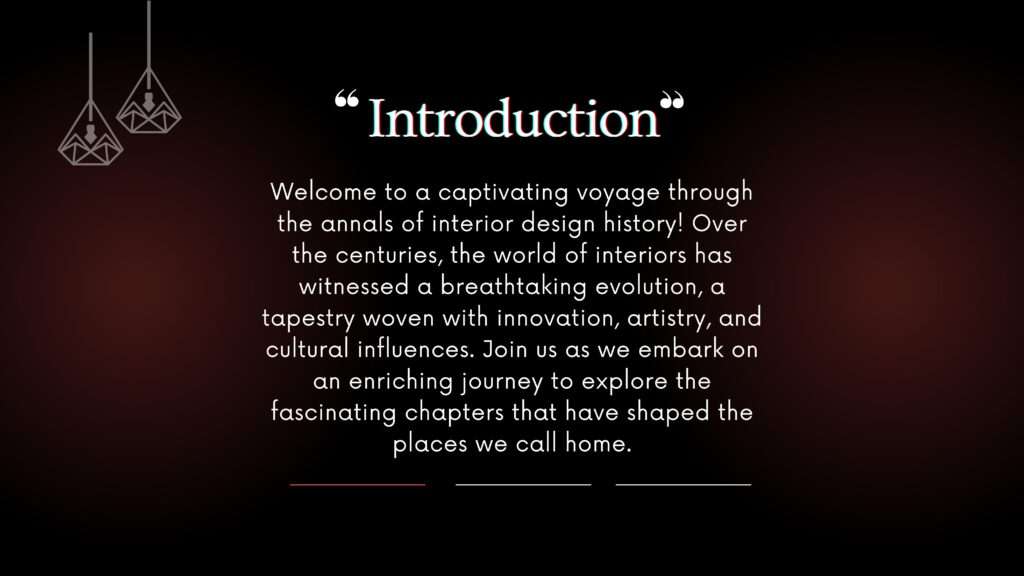
Interior Design is the art and science of enhancing the interior of a space to create a more aesthetically pleasing and functional environment. Interior design is a relatively young profession that emerged in the late 19th and early 20th centuries. but its roots can be traced back to ancient civilizations that decorated their dwellings with various elements.
In this blog post, we will explore some of the major milestones and influences that shaped interior design history, from ancient times to modern trends.
Ancient Civilizations
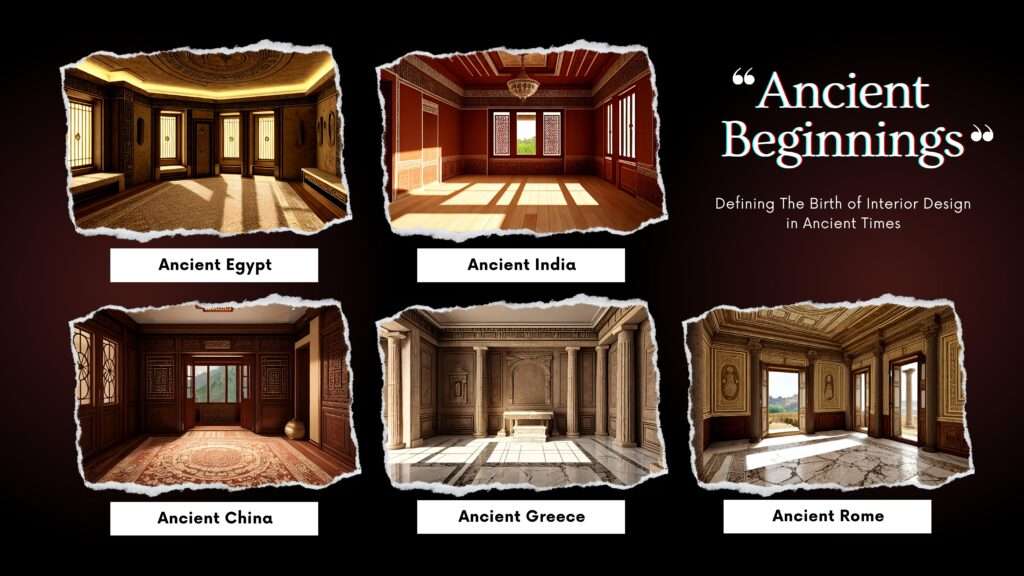
The first signs of interior design can be found in the ancient cultures of Egypt, India, China, Greece, and Rome. These civilizations used various materials, colors, patterns, furniture, textiles, and artworks to adorn their interiors and express their cultural identity and beliefs.
Ancient Egypt:
The Egyptians built elaborate tombs for their pharaohs and nobles, filled with furniture, sculptures, paintings, and hieroglyphs. They used bright colors such as blue, gold, red, and green to symbolize different aspects of life and the afterlife. They also used geometric motifs and animal forms to create patterns and designs.
Ancient India:
The Indians developed a sophisticated system of architecture and design based on the principles of Vastu Shastra, which aimed to harmonize the human and natural worlds. They used wood, stone, metal, and fabrics to create intricate structures and interiors. They also used rich colors such as red, yellow, green, and purple to represent different gods and goddesses.
Ancient China:
The Chinese followed the philosophy of Feng Shui, which focused on creating balance and harmony between the elements of nature. They used wood, bamboo, silk, paper, and ceramics to craft elegant and refined interiors. They also used colors such as black, white, red, and yellow to represent the yin and yang forces.
Ancient Greece:
The Greeks were influenced by the cultures of Egypt and Mesopotamia, but developed their own style of architecture and design. They used marble, stone, wood and metal to build temples, theaters, stadiums and houses. They also used colors such as white, blue, red and gold to reflect their ideals of beauty and order.
Ancient Rome:
The Romans borrowed from the Greeks but added their own innovations and flair. They used concrete, brick, mosaic, glass and plaster to construct monumental buildings and lavish villas. They also used colors such as purple, green, orange and silver to display their wealth and status.
Middle Ages
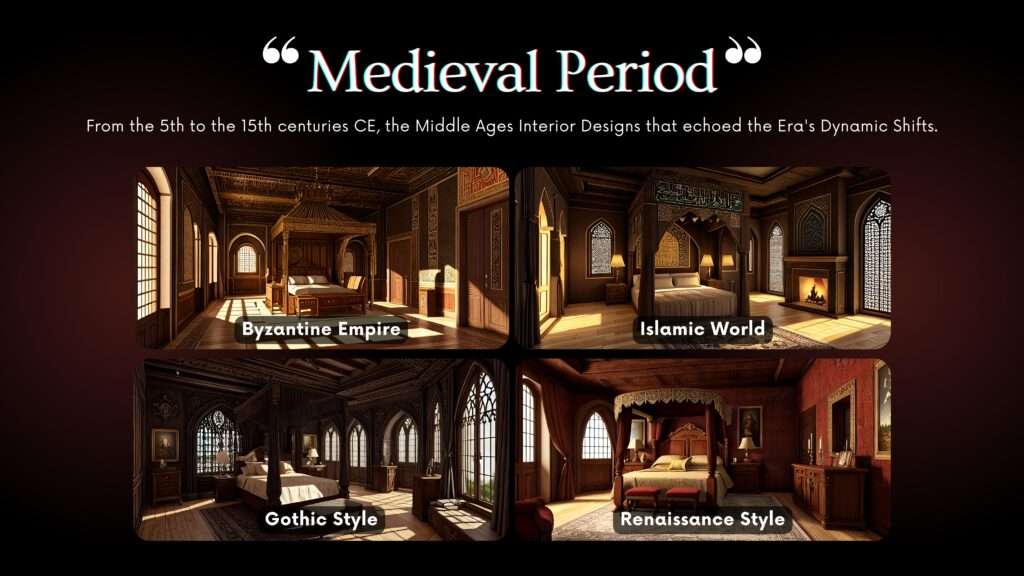
The Middle Ages spanned from the 5th to the 15th centuries CE, and saw the rise and fall of various empires and kingdoms in Europe, Asia and Africa. The interior design history of this period was influenced by the religious, political and social changes that occurred during this time.
Byzantine Empire:
The Byzantine Empire was the continuation of the Roman Empire in the east. It was known for its artistic and cultural achievements, especially in the fields of mosaic art, icon painting and architecture. Domes, arches, columns and rich colors such as gold, blue, red and green characterized the Byzantine interiors.
Islamic World:
The Islamic world encompassed a vast area that stretched from Spain to India. It was marked by its diversity of cultures, languages and traditions. The Islamic interiors were influenced by the principles of geometry, symmetry and arabesque patterns. They used materials such as wood, stone,
tile and metal to create ornate interiors that reflected their faith
and culture.
Gothic Style:
The Gothic style emerged in France in the 12th century and spread throughout Europe. It was inspired by the architecture of cathedrals and castles that featured pointed arches, vaulted ceilings, flying buttresses, and stained glass windows. The Gothic interiors were dark, mysterious, and dramatic, with colors such as black, purple, red, and gold.
Renaissance Style:
The Renaissance style revived the classical ideals of ancient Greece and Rome in the 14th century and flourished in Italy and other parts of Europe. It was characterized by humanism, rationalism, and realism, as well as its artistic and scientific achievements. The Renaissance interiors were light, spacious, and elegant, with colors such as white, cream, pink, and blue.
Modern Times
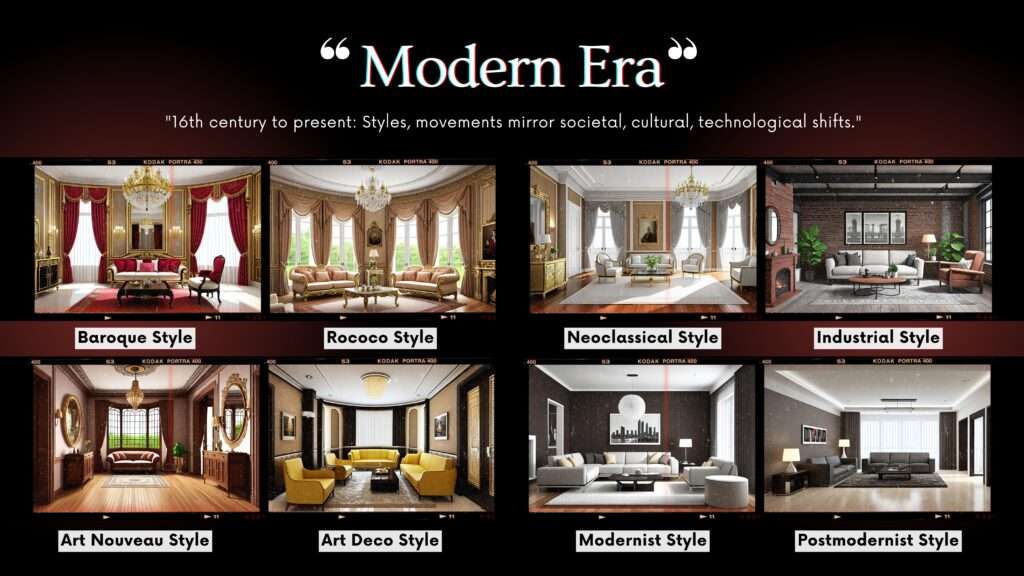
The modern times cover from the 16th century to the present day and witnessed the emergence of various styles and movements in interior design history that reflected the social, cultural, and technological changes that occurred during this period.
Baroque Style:
The Baroque style originated in Italy in the late 16th century and spread throughout Europe. It was influenced by the Catholic Counter-Reformation and the absolutist monarchies that sought to impress and awe their subjects. The Baroque interiors were extravagant, opulent, and theatrical, with colors such as gold, silver, red, and black.
Rococo Style:
The Rococo style developed in France in the early 18th century and was a reaction to the Baroque style. The aristocracy and upper classes favored it, wanting to create a more intimate and playful atmosphere. The Rococo interiors were delicate, ornamental, and whimsical, with colors such as pastel, ivory, pink, and blue.
Neoclassical Style:
The Neoclassical style emerged in the late 18th century and was inspired by the rediscovery of the ancient civilizations of Greece and Rome. It was a response to the excesses of the Baroque and Rococo styles, as well as the political and social upheavals of the French Revolution and the American Revolution. The Neoclassical interiors were simple, symmetrical, and elegant, with colors such as white, cream, gray, and green.
Industrial Style:
The Industrial style emerged in the late 19th and early 20th centuries and was influenced by the Industrial Revolution that transformed the economy, society, and environment of the world. It was characterized by its use of materials such as iron, steel, brick, and concrete to create functional and efficient interiors that exposed their structural and mechanical elements. The industrial interiors were raw, rugged, and minimalist, with colors such as black, brown, gray, and metallic.
Art Nouveau Style:
The Art Nouveau style originated in France in the late 19th and early 20th centuries
and was a reaction to the Industrial style. It was influenced by the natural forms and structures of plants, animals and human figures, as well as the exotic cultures of Japan and Africa. It was an attempt to create a new and original style that integrated art and design. The Art Nouveau interiors were organic, curvilinear and decorative, with colors such as green, yellow, purple and copper.
Art Deco Style:
The Art Deco style emerged in France in the 1920s and 1930s and was influenced by the geometric shapes and patterns of Cubism, Futurism and Constructivism, as well as the cultural influences of Egypt, China and America. It was a celebration of modernity, luxury and glamour that coincided with the Jazz Age and the Roaring Twenties. The Art Deco interiors were sleek, geometric and glamorous, with colors such as black, white, silver and gold.
Modernist Style:
The Modernist style emerged in Europe in the early 20th century and was influenced by the principles of functionality, rationality and simplicity. It was a rejection of historical styles and ornamentation that dominated previous eras. The technological innovations and social changes that occurred during this time also influenced it. Modernist interiors were clean, minimalist and functional, with colors such as white, black, gray and primary.
Postmodernist Style:
The Postmodernist style emerged in the late 20th century and was a reaction to the Modernist style. It was influenced by the concepts of diversity, complexity and irony. The cultural movements of Pop Art, Deconstructivism and Poststructuralism also influenced it. It was an attempt to challenge the norms and conventions of modern design and to create a more playful and eclectic style. The Postmodernist interiors were colorful, quirky and eclectic, with colors such as neon, pastel, metallic and rainbow.
Contemporary Trends
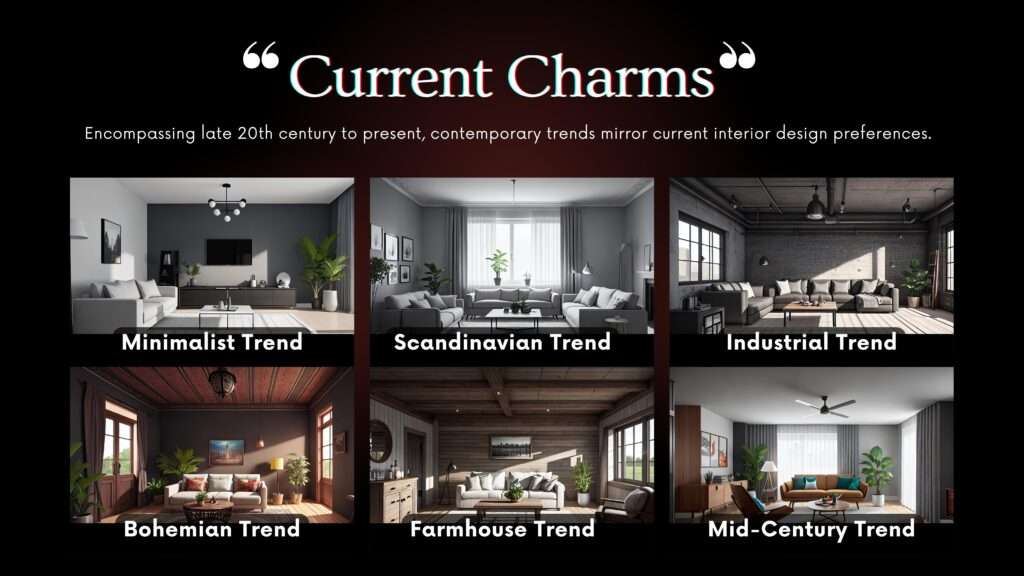
Contemporary trends cover from the late 20th century to the present day, and reflect the current preferences and tastes of interior design. They are influenced by various factors such as globalization, sustainability, technology and personalization. Various styles and movements also influence them from the past and present.
Some of the contemporary trends in interior design history are:
Minimalist Trend:
The Modernist style inspires the Minimalist trend and focuses on creating simple, uncluttered and serene spaces that emphasize quality over quantity. It uses materials such as wood, metal, glass and stone to create sleek and smooth surfaces. It uses colors such as white, black, gray and neutral to create a calm and harmonious atmosphere.
Scandinavian Trend:
The Nordic countries of Denmark, Norway, Sweden and Finland inspire the Scandinavian trend. It focuses on creating cozy, comfortable and functional spaces that combine natural elements with modern design. It uses materials such as wood, wool, leather and fur to create warm and inviting textures. It uses colors such as white, beige, blue and green to create a bright and airy atmosphere.
Industrial Trend:
The Industrial style inspires the Industrial trend and focuses on creating urban, edgy and rustic spaces. In the world of industrial interior design, the latest trends seamlessly blend the raw and the refined. Think exposed brick, cool concrete, and sleek metal fixtures, all warmed up with the cozy embrace of wood and supple leather. Earthy tones and eco-friendly materials take center stage, showcasing a deep connection to nature. This trend crafts spaces that harmonize edgy industrial charm with a genuinely inviting ambiance.
Bohemian Trend:
The free-spirited and artistic lifestyle of the bohemians inspire the Bohemian trend. It focuses on creating eclectic, colorful and expressive spaces that mix and match various styles, cultures and eras. It uses materials such as cotton, linen, silk and velvet to create cozy and comfortable textures. It uses colors such as red, orange, yellow and purple to create a vibrant and lively atmosphere.
Farmhouse Trend:
The rural and rustic style of the countryside inspires the Farmhouse trend. It focuses on creating cozy, charming and nostalgic spaces that evoke a sense of home and family. It uses materials such as wood, metal, stone and ceramic to create natural and organic surfaces. It uses colors such as white, cream, brown and green to create a fresh and soothing atmosphere.
Mid-Century Modern Trend:
The design movement that emerged in the 1950s and 1960s inspires the Mid-Century Modern trend. It focuses on creating sleek, elegant and functional spaces that combine organic forms with geometric shapes. It uses materials such as wood, metal, plastic and glass to create smooth and polished surfaces. It uses colors such as black, white, gray and pastel to create a sophisticated and refined atmosphere.
Conclusion of the Interior Design History
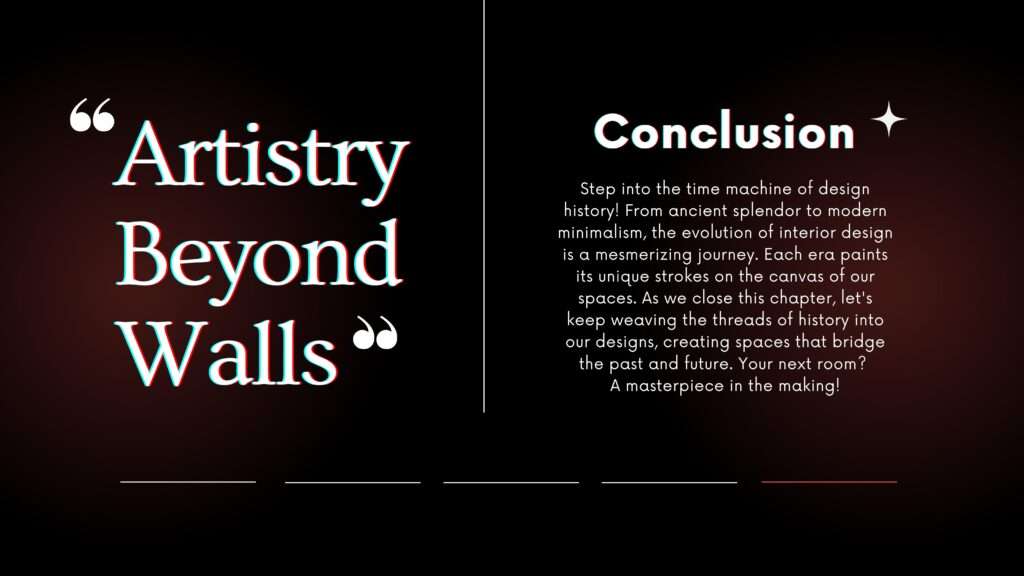
Interior design is a fascinating and dynamic field that reflects the evolution of human civilization, culture and technology. From ancient times to modern trends, interior design history has been a way of expressing our identity, personality, and taste through our living spaces. Interior design is not only an art, but also a science that aims to create environments that are not only beautiful, but also comfortable, functional and sustainable.
If you are interested in learning more about interior design history, you can check out these sources:
- – [Interior design | Definition, History, Styles, & Facts | Britannica]
- – [Interior Design History And Origins Explained – Décor Aid]
- – [What is the INTERIOR DESIGN HISTORY AND its Amazing ORIGINS TIMELINE …]
- – [From Ancient Times to Modern Trends: A Journey through the History of …]
- – [The History of Interior Design By sbid.org]
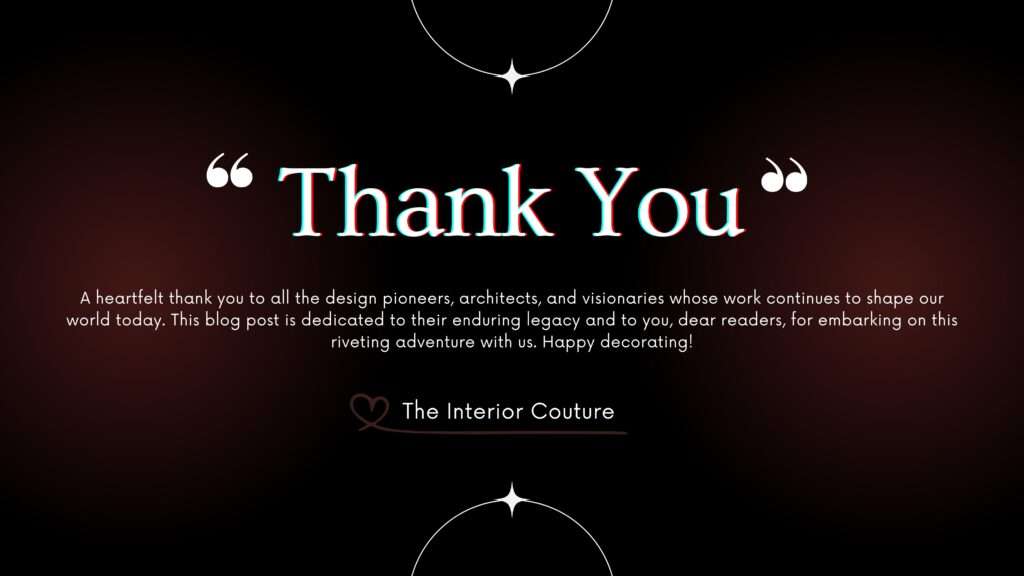
I hope you enjoyed this blog post and learned something new about interior design history. Thank you for reading!





I like this weblog very much, Its a really nice post to read and receive
information.Expand blog